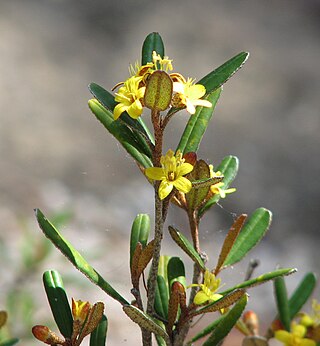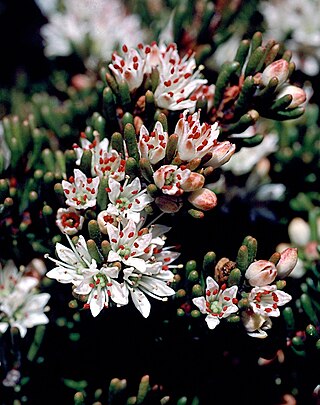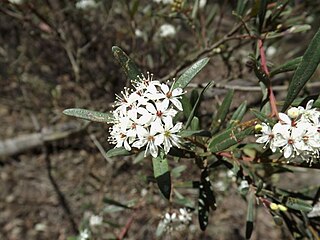
Phebalium whitei is a small shrub that is endemic to south-east Queensland. It has branchlets covered with silvery and rust-coloured scales, leathery, oblong to elliptic leaves and bright yellow flowers arranged in sessile umbels on the ends of branchlets.

Phebalium stenophyllum, commonly known as narrow-leaved phebalium, is a species of small shrub that is endemic to south-eastern Australia. It has scaly branchlets, narrow oblong to more or less cylindrical leaves and yellow flowers in umbels of three to ten.

Philotheca spicata, commonly known as pepper and salt, is a species of flowering plant in the family Rutaceae and is endemic to the south-west of Western Australia. It is a small shrub with linear to narrow elliptical leaves and pink, mauve or blue flowers arranged in a raceme on the ends of branchlets.

Phebalium squamulosum , commonly known as scaly phebalium or forest phebalium, is a species of shrub or slender tree that is endemic to eastern Australia. It has smooth branches covered with rust-coloured scales, linear to elliptical or egg-shaped leaves with the narrower end towards the base, and pale to bright yellow flowers in umbels with rust-coloured or silvery scales on the back.

Leionema phylicifolium, commonly known as alpine phebalium, is a shrub that is endemic to south-eastern Australia. It is a small shrub with green, smooth, leathery leaves and pale yellow flowers in spring.
Nematolepis frondosa, commonly known as leafy nematolepis, is a shrub that is endemic to Victoria, Australia. It is a small, conical shaped shrub with glossy leaves, scaly branchlets and white flowers in winter and spring.

Leionema montanum, is a small shrub with terminal clusters of white-pink flowers in upper leaf axils in spring. It is endemic to Tasmania.
Phebalium brachycalyx is a species of shrub that is endemic to the southwest of Western Australia. It is more or less covered with silvery and rust-coloured scales, and has narrow oblong leaves with wavy-glandular edges, and white to pale yellow flowers in umbels on the ends of branches.
Phebalium drummondii is a species of small shrub that is endemic to Western Australia. It has smooth branchlets covered with silvery scales, broadly elliptic to egg-shaped leaves with silvery scales on the lower side and bright yellow flowers arranged in umbers on the ends of branchlets.

Phebalium festivum, commonly known as dainty phebalium, is a species of spreading shrub that is endemic to Victoria, Australia. It has smooth branchlets, broadly egg-shaped, warty leaves and three to ten white or pale yellow flowers arranged in umbels on the ends of branchlets.

Leionema obtusifolium, is a small shrub with yellow-white flowers in terminal clusters at the end of branches. It is endemic to Queensland.

Phebalium obcordatum, commonly known as the club-leaved phebalium, is a species of shrub that is endemic to New South Wales. It has smooth branchlets, small egg-shaped to heart-shaped leaves with the narrower end towards the base and small umbels of pale yellow flowers with silvery scales on the back of the petals.
Phebalium obovatum is a species of spreading shrub that is endemic to Western Australia. It has thick, egg-shaped or elliptical leaves densely covered with silvery scales on the lower side and white flowers arranged in umbels with silvery or rust-coloured scales on the back.

Leionema ralstonii, is a small shrub with angular, smooth branchlets and pale green flowers in winter. It is restricted to the south coast of New South Wales.

Leionema rotundifolium, is a dense shrub with needle-shaped stems and pale lemon to white terminal flowers. It is found in New South Wales and Queensland.
Leionema sympetalum, commonly known as Rylstone bell, is a shrub with greenish-yellow tubular flowers in small terminal clusters at the end of smooth, angular branches. It has a restricted distribution, grows near Rylstone in New South Wales.

Leionema viridiflorum commonly known as green phebalium, is a species of flowering plant in the family Rutaceae. It is a small shrub with pale yellow-greenish flowers in clusters at the end of branches from winter to early spring. It has a restricted distribution in northern New South Wales.

Rhadinothamnus euphemiae, is a slender, small, upright shrub with needle-shaped branchlets thickly covered with silvery scales and tubular greenish-purple tubular flowers throughout the year. It is endemic to the south coast of Western Australia.

Nematolepis ovatifolia, is a small shrub with rusty coloured scales on the stems, smooth, glossy leaves and white flowers in small clusters in summer. It is endemic to New South Wales.
Nematolepis rhytidophylla, is a dense shrub with angular stems, covered densely in coppery coloured scales, smooth, glossy leaves and white flowers in small clusters in winter and spring. It is endemic to New South Wales.














